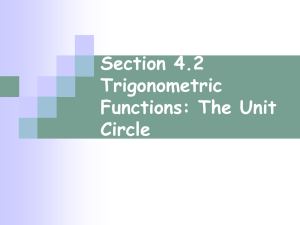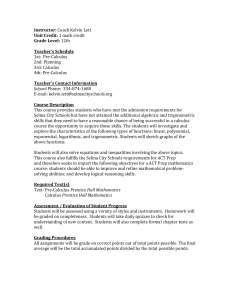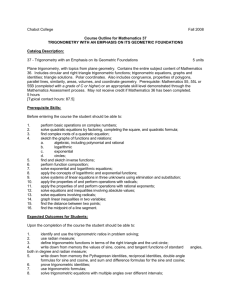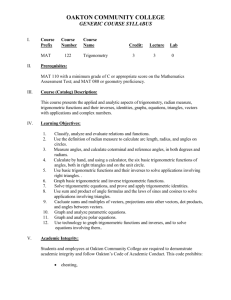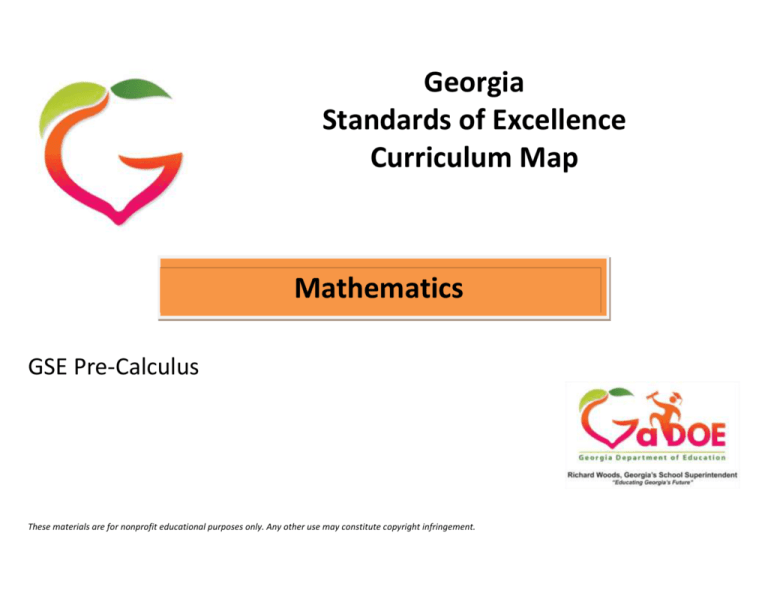
Georgia
Standards of Excellence
Curriculum Map
Mathematics
GSE Pre-Calculus
These materials are for nonprofit educational purposes only. Any other use may constitute copyright infringement.
Georgia Department of Education
GSE Pre-Calculus Curriculum Map
1st Semester
2nd Semester
Unit 1
Unit 2
Unit 3
Unit 4
Unit 5
Unit 6
Unit 7
Unit 8
Introduction to
Trigonometric
Functions
(4 – 5 weeks)
Trigonometric
Functions
(4 – 5 weeks)
Trigonometry of
General
Triangles
(3 – 4 weeks)
Trigonometric
Identities
(3 – 4 weeks)
Matrices
(3 – 4 weeks)
Conics
(3 – 4 weeks)
Vectors
(4 – 5 weeks)
Probability
(4 – 5 weeks)
MGSE9-12.F.IF.4
MGSE9-12.F.IF.7
MGSE9-12.F.IF.7e
MGSE9-12.F.TF.1
MGSE9-12.F.TF.2
MGSE9-12.F.TF.5
MGSE9-12.F.TF.8
MGSE9-12.F.BF.4
MGSE9-12.F.BF.4d
MGSE9-12.F.TF.3
MGSE9-12.F.TF.4
MGSE9-12.F.TF.6
MGSE9-12.F.TF.7
MGSE.9-12.G.SRT.9
MGSE.9-12.G.SRT.10
MGSE.9-12.G.SRT.11
MGSE9-12.F.TF.9
MGSE9-12.N.VM.6
MGSE9-12.N.VM.7
MGSE9-12.N.VM.8
MGSE9-12.N.VM.9
MGSE9-12.N.VM.10
MGSE9-12.N.VM.12
MGSE9-12.A.REI.8
MGSE9-12.A.REI.9
MGSE9-12.G.GPE.2
MGSE9-12.G.GPE.3
MGSE9-12.A.REI.7
MGSE9-12.N.CN.3
MGSE9-12.N.CN.4
MGSE9-12.N.CN.5
MGSE9-12.N.CN.6
MGSE9-12.N.VM.1
MGSE9-12.N.VM.2
MGSE9-12.N.VM.3
MGSE9-12.N.VM4
MGSE9-12.N.VM4a
MGSE9-12.N.VM4b
MGSE9-12.N.VM4c
MGSE9-12.N.VM.5
MGSE9-12.N.VM.5a
MGSE9-12.N.VM.5b
MGSE9-12.N.VM.11
MGSE9-12.S.CP.8
MGSE9-12.S.CP.9
MGSE9-12.S.MD.1
MGSE9-12.S.MD.2
MGSE9-12.S.MD.3
MGSE9-12.S.MD.4
MGSE9-12.S.MD.5
MGSE9-12.S.MD.5a
MGSE9-12.S.MD.5b
MGSE9-12.S.MD.6
MGSE9-12.S.MD.7
These units were written to build upon concepts from prior units, so later units contain tasks that depend upon the concepts addressed in earlier units.
All units will include the Mathematical Practices and indicate skills to maintain.
*Revised standards indicated in bold red font.
NOTE: Mathematical standards are interwoven and should be addressed throughout the year in as many different units and tasks as possible in order to stress the natural connections that exist among mathematical topics.
Grade 9-12 Key:
Number and Quantity Strand: RN = The Real Number System, Q = Quantities, CN = Complex Number System, VM = Vector and Matrix Quantities
Algebra Strand: SSE = Seeing Structure in Expressions, APR = Arithmetic with Polynomial and Rational Expressions, CED = Creating Equations, REI = Reasoning with Equations and Inequalities
Functions Strand: IF = Interpreting Functions, LE = Linear and Exponential Models, BF = Building Functions, TF = Trigonometric Functions
Geometry Strand: CO = Congruence, SRT = Similarity, Right Triangles, and Trigonometry, C = Circles, GPE = Expressing Geometric Properties with Equations, GMD = Geometric Measurement and Dimension,
MG = Modeling with Geometry
Statistics and Probability Strand: ID = Interpreting Categorical and Quantitative Data, IC = Making Inferences and Justifying Conclusions, CP = Conditional Probability and the Rules of Probability, MD = Using Probability
to Make Decisions
Richard Woods, State School Superintendent
July 2015
All Rights Reserved
Georgia Department of Education
Georgia Standards of Excellence Pre-Calculus
Curriculum Map Rationale
Unit 1: Students will use the unit circle to extend the domain of trigonometric functions to include all real numbers. Students will develop
understanding of the radian measure of an angle, graph trigonometric functions, and derive and apply the Pythagorean identity.
Unit 2: Building on standards from Unit 1, students extend their study of the unit circle and trigonometric functions. Students will create inverses of
trigonometric functions and use the inverse functions to solve trigonometric equations that arise in real-world problems.
Unit 3: Building on standards from Unit 1 and Unit 2, students will apply trigonometry to general triangles. Students will derive the trigonometric
formula for the area of a triangle and prove and use the Laws of Sines and Cosines to solve problems.
Unit 4: Building on standards from the first three units, students will prove and use addition, subtraction, double, and half-angle formulas to solve
problems.
Unit 5: Students will perform operations on matrices, use matrices in applications, and use matrices to represent and solve systems of equations.
Unit 6: Building on standards from previous courses, students will derive the equations of conic sections (parabolas, ellipses, and hyperbolas). Students
will solve systems of a linear and quadratic equation in two variables.
Unit 7: Students will extend their understanding of complex numbers and their operations through graphical representations. Students will perform
operations on vectors and use the operations to represent various quantities.
Unit 8: Students will extend their study of probability by computing and interpreting probabilities of compound events. Students will calculate expected
values and use them to solve problems and make informed decisions.
Richard Woods, State School Superintendent
July 2015
All Rights Reserved
Georgia Department of Education
GSE Pre-Calculus Expanded Curriculum Map – 1st Semester
Standards for Mathematical Practice
5 Use appropriate tools strategically.
6 Attend to precision.
7 Look for and make use of structure.
8 Look for and express regularity in repeated reasoning.
1st Semester
1 Make sense of problems and persevere in solving them.
2 Reason abstractly and quantitatively.
3 Construct viable arguments and critique the reasoning of others.
4 Model with mathematics.
Unit 1
Unit 2
Unit 3
Unit 4
Introduction to Trigonometric
Functions
Trigonometric Functions
Trigonometry of General Triangles
Trigonometric Identities
Interpret functions that arise in
applications in terms of the context
MGSE9-12.F.IF.4 Using tables, graphs, and
verbal descriptions, interpret the key
characteristics of a function which models
the relationship between two quantities.
Sketch a graph showing key features
including: intercepts; interval where the
function is increasing, decreasing, positive,
or negative; relative maximums and
minimums; symmetries; end behavior; and
periodicity.
Analyze functions using different
representations
MGSE9-12.F.IF.7 Graph functions
expressed algebraically and show key
features of the graph both by hand and by
using technology.
MGSE9-12.F.IF.7e Graph exponential and
logarithmic functions, showing intercepts and
end behavior, and trigonometric functions,
showing period, midline, and amplitude.
Extend the domain of trigonometric
functions using the unit circle
MGSE9-12.F.TF.1 Understand radian
measure of an angle as the length of the arc on
the unit circle subtended by the angle.
MGSE9-12.F.TF.2 Explain how the unit
circle in the coordinate plane enables the
extension of trigonometric functions to all real
numbers, interpreted as radian measures of
angles traversed counterclockwise around the
unit circle.
Model periodic phenomena with
trigonometric functions
Build new functions from existing functions
MGSE9-12.F.BF.4 Find inverse functions.
MGSE9-12.F.BF.4d Produce an invertible
function from a non-invertible function by
restricting the domain.
MGSE9-12.F.TF.3 Use special triangles to
determine geometrically the values of sine,
cosine, tangent for π/3, π/4 and π/6, and use
the unit circle to express the values of sine,
cosine, and tangent for π - x, π + x, and 2π - x
in terms of their values for x, where x is any
real number.
MGSE9-12.F.TF.4 Use the unit circle to
explain symmetry (odd and even) and
periodicity of trigonometric functions.
MGSE9-12.F.TF.6 Understand that
restricting a trigonometric function to a
domain on which it is always increasing or
always decreasing allows its inverse to be
constructed.
MGSE9-12.F.TF.7 Use inverse functions to
solve trigonometric equations that arise in
modeling contexts; evaluate the solutions
using technology, and interpret them in terms
of the context.
Apply trigonometry to general triangles
MGSE9-12.G.SRT.9 Derive the formula
A = (1/2)ab sin(C) for the area of a triangle by
drawing an auxiliary line from a vertex
perpendicular to the opposite side.
MGSE9-12.G.SRT.10 Prove the Laws of
Sines and Cosines and use them to solve
problems.
MGSE9-12.G.SRT.11 Understand and apply
the Law of Sines and the Law of Cosines to
find unknown measurements in right and nonright triangles (e.g., surveying problems,
resultant forces).
Prove and apply trigonometric identities
MGSE9-12.F.TF.9 Prove addition,
subtraction, double and half-angle formulas
for sine, cosine, and tangent and use them
to solve problems.
Richard Woods, State School Superintendent
July 2015
All Rights Reserved
Georgia Department of Education
MGSE9-12.F.TF.5 Choose trigonometric
functions to model periodic phenomena with
specified amplitude, frequency, and midline.
Prove and apply trigonometric identities
MGSE9-12.F.TF.8 Prove the Pythagorean
identity (sin A)2+ (cos A)2= 1 and use it to
find sin A, cos A, or tan A, given sin A, cos A,
or tan A, and the quadrant of the angle.
Richard Woods, State School Superintendent
July 2015
All Rights Reserved
Georgia Department of Education
GSE Pre-Calculus Expanded Curriculum Map – 2nd Semester
Standards for Mathematical Practice
5 Use appropriate tools strategically.
6 Attend to precision.
7 Look for and make use of structure.
8 Look for and express regularity in repeated reasoning.
2nd Semester
1 Make sense of problems and persevere in solving them.
2 Reason abstractly and quantitatively.
3 Construct viable arguments and critique the reasoning of others.
4 Model with mathematics.
Unit 5
Unit 6
Unit 7
Unit 8
Matrices
Conics
Vectors
Probability
Perform operations on matrices and use
matrices in applications
MGSE9-12.N.VM.6 Use matrices to
represent and manipulate data, e.g.,
transformations of vectors.
MGSE9-12.N.VM.7 Multiply matrices by
scalars to produce new matrices.
MGSE9-12.N.VM.8 Add, subtract, and
multiply matrices of appropriate dimensions.
MGSE9-12.N.VM.9 Understand that, unlike
multiplication of numbers, matrix
multiplication for square matrices is not a
commutative operation, but still satisfies the
associative and distributive properties.
MGSE9-12.N.VM.10 Understand that the
zero and identity matrices play a role in matrix
addition and multiplication similar to the role
of 0 and 1 in the real numbers. The
determinant of a square matrix is nonzero if
and only if the matrix has a multiplicative
inverse.
MGSE9-12.N.VM.12 Work with 2 X 2
matrices as transformations of the plane, and
interpret the absolute value of the determinant
in terms of area.
Solve systems of equations
MGSE9-12.A.REI.8 Represent a system of
linear equations as a single matrix equation in
a vector variable
MGSE9-12.A.REI.9 Find the inverse of a
matrix if it exists and use it to solve systems of
linear equations (using technology for
matrices of dimension 3 × 3 or greater).
Translate between the geometric
description and the equation for a conic
section
MGSE9-12.G.GPE.2 Derive the equation of a
parabola given a focus and directrix.
MGSE9-12.G.GPE.3 Derive the equations of
ellipses and hyperbolas given the foci, using
the fact that the sum or difference of distances
from the foci is constant.
Solve systems of equations
MGSE9-12.A.REI.7 Solve a simple system
consisting of a linear equation and a quadratic
equation in two variables algebraically and
graphically. For example, find the points of
intersection between the line y = –3x and the
circle x2 + y2 = 3.
Use properties of rational and irrational
numbers.
MGSE9-12.N.CN.3 Find the conjugate of a
complex number; use the conjugate to find
the absolute value (modulus) and quotient
of complex numbers.
Represent complex numbers and their
operations on the complex plane
MGSE9-12.N.CN.4 Represent complex
numbers on the complex plane in rectangular
and polar form (including real and imaginary
numbers), and explain why the rectangular and
polar forms of a given complex number
represent the same number.
MGSE9-12.N.CN.5 Represent addition,
subtraction, multiplication, and conjugation of
complex numbers geometrically on the
complex plane; use properties of this
representation for computation. For example,
(-1 + √3i)3 = 8 because (-1 + √3i) has
modulus 2 and argument 120°.
MGSE9-12.N.CN.6 Calculate the distance
between numbers in the complex plane as the
modulus of the difference, and the midpoint of
a segment as the average of the numbers at its
endpoints.
Represent and model with vector quantities
MGSE9-12.N.VM.1 Recognize vector
quantities as having both magnitude and
direction. Represent vector quantities by
directed line segments, and use appropriate
symbols for vectors and their magnitudes
(e.g., v, |v|, ||v||, v).
MGSE9-12.N.VM.2 Find the components of
a vector by subtracting the coordinates of an
initial point from the coordinates of a terminal
point.
Use the rules of probability to compute
probabilities of compound events in a
uniform probability model
MGSE9-12.S.CP.8 Apply the general
Multiplication Rule in a uniform probability
model, P(A and B) = [P(A)]x[P(B|A)]
=[P(B)]x[P(A|B)], and interpret the answer in
terms of the model.
MGSE9-12.S.CP.9 Use permutations and
combinations to compute probabilities of
compound events and solve problems.
Calculate expected values and use them to
solve problems
MGSE9-12.S.MD.1 Define a random variable
for a quantity of interest by assigning a
numerical value to each event in a sample
space; graph the corresponding probability
distribution using the same graphical displays
as for data distributions.
MGSE9-12.S.MD.2 Calculate the expected
value of a random variable; interpret it as the
mean of the probability distribution.
MGSE9-12.S.MD.3 Develop a probability
distribution for a random variable defined for
a sample space in which theoretical
probabilities can be calculated; find the
expected value. For example, find the
theoretical probability distribution for the
number of correct answers obtained by
guessing on all five questions of a multiplechoice test where each question has four
choices, and find the expected grade under
various grading schemes.
MGSE9-12.S.MD.4 Develop a probability
distribution for a random variable defined for
a sample space in which probabilities are
assigned empirically; find the expected value.
Richard Woods, State School Superintendent
July 2015
All Rights Reserved
Georgia Department of Education
MGSE9-12.N.VM.3 Solve problems
involving velocity and other quantities that
can be represented by vectors.
Perform operations on vectors
MGSE9-12.N.VM.4 Add and subtract
vectors.
MGSE9-12.N.VM4a Add vectors end-to-end,
component-wise, and by the parallelogram
rule. Understand that the magnitude of a sum
of two vectors is typically not the sum of the
magnitudes.
MGSE9-12.N.VM4b Given two vectors in
magnitude and direction form, determine the
magnitude and direction of their sum.
MGSE9-12.N.VM4c Understand vector
subtraction v – w as v + (–w), where (–w) is
the additive inverse of w, with the same
magnitude as w and pointing in the opposite
direction. Represent vector subtraction
graphically by connecting the tips in the
appropriate order, and perform vector
subtraction component-wise.
MGSE9-12.N.VM.5 Multiply a vector by a
scalar.
MGSE9-12.N.VM.5a Represent scalar
multiplication graphically by scaling vectors
and possibly reversing their direction; perform
scalar multiplication component-wise, e.g., as
c(vx, vy) = (cvx, cvy).
MGSE9-12.N.VM.5b Compute the
magnitude of a scalar multiple cv using ||cv|| =
|c|v. Compute the direction of cv knowing that
when |c|v = 0, the direction of cv is either
along v (for c > 0) or against v (for c < 0).
MGSE9-12.N.VM.11 Multiply a vector
(regarded as a matrix with one column) by a
matrix of suitable dimensions to produce
another vector. Work with matrices as
transformations of vectors.
Richard Woods, State School Superintendent
July 2015
All Rights Reserved
For example, find a current data distribution
on the number of TV sets per household in the
United States, and calculate the expected
number of sets per household. How many TV
sets would you expect to find in 100 randomly
selected households?
Use probability to evaluate outcomes of
decisions
MGSE9-12.S.MD.5 Weigh the possible
outcomes of a decision by assigning
probabilities to payoff values and finding
expected values.
MGSE9-12.S.MD.5a Find the expected
payoff for a game of chance. For example,
find the expected winnings from a state lottery
ticket or a game at a fast-food restaurant.
MGSE9-12.S.MD.5b Evaluate and compare
strategies on the basis of expected values. For
example, compare a high-deductible versus a
low-deductible automobile insurance policy
using various, but reasonable, chances of
having a minor or a major accident.
MGSE9-12.S.MD.6 Use probabilities to make
fair decisions (e.g., drawing by lots, using a
random number generator).
MGSE9-12.S.MD.7 Analyze decisions and
strategies using probability concepts (e.g.,
product testing, medical testing, pulling a
hockey goalie at the end of a game).




